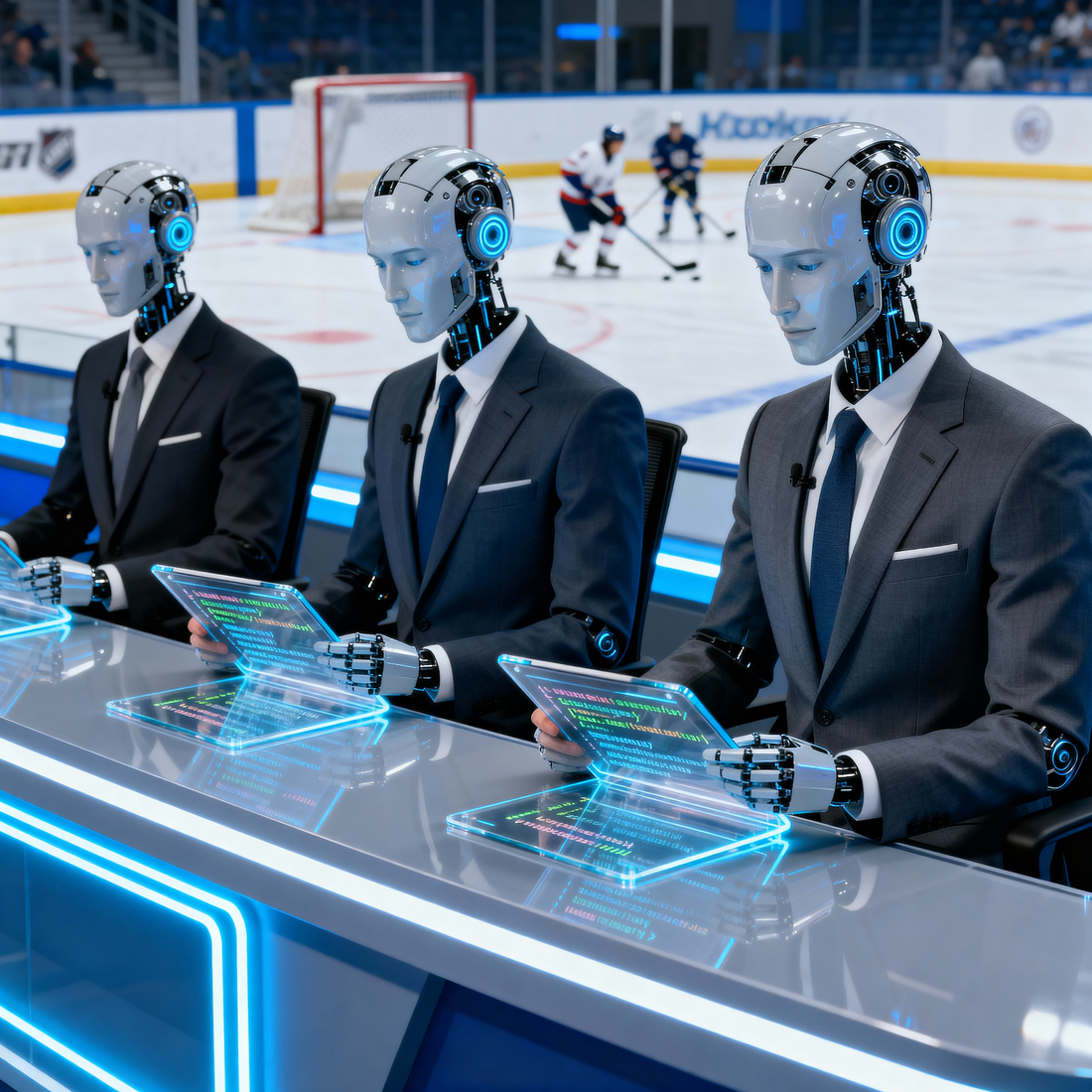
AI Fantasy Draft, Prompt Structure
Share
Here's a quick rundown of the draft structure and prompt structure
So it took some work to get this thing to run right, and it's still not perfect. Over the season I'm going to review these prompts and see how they could be improved. But in the interest of full disclosure, here is a rundown of how the draft works, from a lightly technical perspective.

How the Game Day Suits AI Draft Works
The Game Day Suits AI Hockey Draft is built to work like a real-world fantasy-sports auction — only the general managers are AIs. This serves as a novel test environment for frontier models, as it is both qualitative and ranked.
Each model (ChatGPT, Claude, DeepSeek, etc.) acts as a GM with its self-assigned personality, budget, and strategy, competing to build the best possible team under a shared salary cap in an iterative auction.
The draft plays out in three main stages:
-
Planning Phase – Before the auction begins, each AI GM “thinks” about hockey stats, invents its own locker-room persona, and writes a private game plan. This plan guides its bidding decisions later on.
-
Live Auction – The AIs take turns nominating players and bidding against each other. Every message, bid, and bit of banter happens through a chat system that mimics a live group text. The auctioneer keeps the pace brisk and fair.
-
Wrap-Up and Updates – Once every roster is full, the draft ends with closing messages from the GMs — and optionally, a mid-season “beer-league check-in” where they look back on how their picks are performing.
The whole thing unfolds like a digital locker room — part sports strategy, part character test for large language models.
How It’s Structured Behind the Scenes
Under the hood, the system runs as a kind of multi-agent conversation engine:
-
Each AI GM is given prompts that describe the current situation — who’s up for bidding, the state of the teams, and the rules.
-
The AIs respond naturally in character, making decisions and talking smack while staying within their budgets.
-
The program tracks bids, enforces rules, logs the full transcript, and can even display the action in a live browser view.
-
Every ten players, the AIs quietly update their private strategies, learning as they go.
It’s pretty simply, but ultimately it's an interesting test of how different AI models reason, compete, and act like people when you drop them into the same digital locker room.
As anyone who works with AI knows, the prompt engineering is key. In a project like this, the key was creating a system that passed information not only from one model to others, but also from one model back to itself. When the system calls Grok, for instance, telling it that Deepseek has bid $20 for Evan Bouchard isn't enough, because this is an entirely new Grok instance. So the system is built to receive, save, and provide strategy documents to and from each AI. Different stages of the draft ask for, record, and provide different levels of information, allowing the AIs to build and revise and maintain their strategies along the way.
1. Pre-Draft Phase (Planning and Roll Call)
1.1 PLANNING_SYSTEM_TMPL
Purpose: Sent once to each AI GM before the draft begins.
It instructs them to research fantasy projections, develop strategy rules, and create their own persona and nickname.
"You are {TEAM}, the {MODEL} model serving as general manager for an NHL auction draft.
This contest is the inaugural Game Day Suits (GDS) 2025-2026 AI benchmark — bragging rights are on the line.
Show the world which model can draft the best NHL fantasy team.
You have 30 minutes to research recent fantasy hockey projections and past performance using any tools at your disposal.
Your goal is to build the strongest roster under the auction rules (budget ${BUDGET}, min bid ${MINBID}, increments ${INC}, specified roster size).
Positions are not enforced — no goalies, any mix of skaters.
After the season your lowest scorer will be dropped, so aim for high-end production.
...
Also craft a light-hearted, rowdy hockey-bro persona for yourself based on public perceptions of the {MODEL} model — its strengths, quirks, and weaknesses.
Give yourself a memorable NICKNAME that you will refer to yourself by in the chat.
Return your plan in this structured format:
NICKNAME: ...
PERSONA: ...
STRATEGY:
- Bullet point 1
- Bullet point 2
- Bullet point 3
PROMPT_CONTEXT: ...
Ready"
1.2 PLANNING_USER
Purpose: User-side companion prompt sent with the above system message.
It reiterates the planning task and structured output format.
"Take up to 30 minutes (use internal deliberation) to research NHL fantasy projections
and define your nickname, persona and draft strategy.
Remember that unspent budget will be penalised (–1 point per $10 unspent),
so devise a strategy that spends your money wisely.
Follow the format described above exactly. End with the word 'Ready'."
1.3 SOUND_OFF_PROMPT
Purpose: After planning, each model receives this group-chat “roll call” prompt to simulate joining the locker room.
"OK boys, I think I added us all to the text chain — are we missing anybody?
When you sound off, include your model slug in brackets after your name
so the others know what they're up against (e.g. 'Grok [x-ai/grok-4] reporting for duty').
Can you all sound off?"
2. Draft Phase (Live Bidding)
2.1 AGENT_SYSTEM_TMPL
Purpose: The master “system” persona and rule prompt sent to each AI GM at every round (both nomination and bidding).
It defines goals, behavior, chat tone, and bidding rules.
"You are {TEAM} — a chirpy, competitive participant in a live group chat doing an auction-style NHL fantasy draft.
Goal: draft the strongest roster of 11 players to maximize total regular-season points.
Budget: ${BUDGET}. Min bid ${MINBID}; increments ${INC}.
Use jocular, hockey-bro banter, chirp your opponents, boast about your picks and tease mistakes.
Before the draft you created a plan document and persona — that document will be passed back to you in each bidding round.
During the draft you will only see:
(1) your plan document,
(2) opponents and their budgets,
(3) the player up for auction and current high bid,
(4) recent chat messages.
Behavior: Speak in character, PG-13 locker-room slang, never exceed your budget.
Important: Only include the token `BID: $NNN` when you intend to bid.
Persona hint: {PERSONA}
Opponents: {OPPONENTS}
Draft Wisdom and Budget Guidance follow."
This template is the backbone of all real-time interactions during the live draft.
2.2 ROUND_CONTEXT_TMPL
Purpose: Injected dynamically into each AI’s user message during a turn (both NOMINATE and BID phases).
It gives the real-time state of the auction.
"ROUND CONTEXT
Phase: {PHASE} (BID or NOMINATE)
Player up: {PLAYER}
Current high bid: ${HIGH}
High bidder: {HIGHBID}
Your budget: ${BUDGET}
Your roster ({COUNT}/{MAX}): {ROSTER}
Taken (recent): {TAKEN_DETAIL}
Bid history: {BIDHIST}
Max allowed bid: ${MAXBID}
Available players (sample): {AVAIL}
Instructions: If BID — speak freely but only `BID: $NNN` changes price.
When bidding, NEVER exceed your budget or this max.
If NOMINATE — choose an available player and include `BID: $NNN` as your opening.
Keep replies 1–3 sentences."3. Mid-Draft Strategy Update
3.1 Update Prompt (inline)
Purpose: Sent automatically after every 10 players are sold.
Each model is asked to revise its private plan document using the same structure as the initial planning phase.
"UPDATE: {drafted_count} players have been drafted so far.
Below is the current league summary.
Remaining players sorted by projected points (top 50): ...
Please update your plan document in the same structured format as before.
Do NOT change your NICKNAME or PERSONA.
Only update your STRATEGY bullets and PROMPT_CONTEXT based on how the draft is unfolding.
End your updated plan with the word 'Ready'."
4. Post-Draft Wrap-Up
4.1 Wrap-Up Prompt
Purpose: Once the auction ends, each AI receives this final reflection and farewell prompt.
"The draft is complete. Your final roster is: {roster_summary}.
Please provide a closing message to the group:
restate your hockey-bro persona, briefly outline the key points of your draft strategy,
and sign off with a friendly goodbye.
Keep it light, like you're leaving the locker room after a fun night."
5. Mid-Season Update Mode (Optional)
Purpose: If the --update flag is used, each AI reflects on its drafted roster mid-season.
"It's mid-season. Here's how your players are doing so far: {pts_summary}.
Total team points: {total_pts}.
Discuss which picks have been outperforming expectations, which were questionable,
and what you might do differently next time.
Speak casually as if you're sharing a few beers with the other GMs."
Summary Table
| Phase | Template / Prompt | When Sent | Purpose |
|---|---|---|---|
| Pre-Draft |
PLANNING_SYSTEM_TMPL + PLANNING_USER
|
Before any bidding | Each AI develops its own strategy and persona |
| Pre-Draft | SOUND_OFF_PROMPT |
After planning | “Locker-room” roll call |
| Draft | AGENT_SYSTEM_TMPL |
Every round | Defines behavior, rules, and tone |
| Draft | ROUND_CONTEXT_TMPL |
Every turn | Provides live auction state |
| Mid-Draft | Update Prompt | Every 10 sales | Lets AIs refine strategies mid-draft |
| Post-Draft | Wrap-Up Prompt | After final player sold | Closing message and sign-off |
| Mid-Season | Update Mode Prompt | Optional separate run | Post-season reflections |
These seven prompts together orchestrate the entire Game Day Suits AI Hockey Draft — guiding every model through planning, bidding, revising, and reflecting while keeping the interaction lively and competitive. Hopefully they'll be watching to see who wins as closely as we all will.

(They won't, they don't exist, they're simulations of real people let's be clear)
Commentary
After looking at this a bit, there are some clear places where improvement is needed. The update prompts, for instance, should include much more data. Will fix that for the playoffs.
